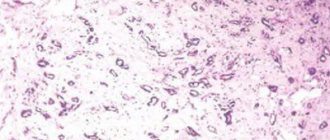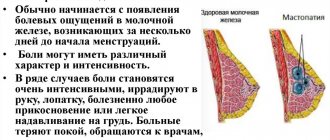There are different types of breast cancer. This pathology may differ in location, type of malignant cells, their differentiation, growth pattern, etc. Depending on the type of breast cancer in women, one or another treatment tactic will be chosen. The further prognosis also depends on the type of cancer. To determine the type of pathology, various research methods are used: biopsy, determination of cancer markers in the blood, testing for hormone dependence of cells, etc. The correct choice of treatment depends on how accurately the diagnosis is established. The Yusupov Hospital uses modern high-precision equipment to diagnose cancer. This allows doctors to create the most effective treatment plan, which will increase the chances of survival for this pathology.
Intraductal cancer
Intraductal breast cancer is the most common type of cancer of this organ. Its symptoms will depend on the type of tumor, its size, and stage of the disease.
There are two main forms of intraductal cancer:
- Non-invasive;
- Invasive.
Intraductal non-invasive breast cancer is determined by analyzing a microscope that is taken during a biopsy. With non-invasive cancer, the tumor does not leave the duct and does not affect neighboring tissues. This type of cancer does not pose a particular threat to a woman’s life, however, it has a high probability of developing into an invasive tumor with further metastases. Intraductal non-invasive cancer is highly treatable, but the patient will need to regularly visit a mammologist and oncologist to monitor the condition of the breast.
Invasive intraductal breast cancer has a poorer prognosis after treatment. In this case, malignant cells spread to neighboring tissues, and over time affect blood vessels and lymph nodes. Intraductal cancer can occur at any age, but postmenopausal women are more prone to it.
Treatment for intraductal cancer will include radical mastectomy, chemotherapy, radiation therapy, the use of hormonal drugs (in the case of a hormone-dependent tumor), as well as targeted therapy to help stop the growth of malignant cells.
Self-detection of adenocarcinoma
Breast adenocarcinoma tends to proceed almost unnoticed, which is why the disease is diagnosed late. The World Association of Mammologists has developed an algorithm for women with which they can independently examine their breasts for the presence of cancer pathologies.
- To do this, a woman must stand in front of the mirror and carefully examine her breasts. Asymmetry and changes in skin color may indicate the presence of cancerous tumors.
- Next, using palpation, you need to feel the entire breast, paying special attention to the area of the areola and nipple. If any lumps are observed, even small ones, the woman should immediately consult a mammologist.
- Next, the armpit is palpated. One of the signs of a cancerous tumor is enlargement of the lymph nodes in this place.
If you have any suspicions, you need to contact a specialist who will prescribe ultrasound diagnostics and radiography. These methods will determine the presence and size of a tumor, if any. All women over 20 years old must be examined by a mammologist once a year.
https://youtu.be/AsUJiUOnEsk
Lobular cancer
Lobular breast cancer is the second most common type of breast cancer. The tumor begins its development in the lobules of the mammary glands (hence the name) from epithelial cells. This type of cancer is also divided into non-invasive and invasive. The first has a favorable prognosis and responds well to treatment. In the second case, full-scale treatment will be applied with removal of the mammary gland followed by chemotherapy and radiation therapy.
Lobular breast cancer has a favorable prognosis if the tumor is detected at stages 1-2. At later stages, the likelihood of metastasis and relapse of the pathology increases significantly, even after a full course of treatment.
Treatment
Curing a cancerous disease can consist of common methods, which are surgery followed by radiotherapy.
Operation
Surgery is the first method of treatment for non-invasive and invasive ductal breast cancer, at any stage of development. It is carried out to completely dry out the tumor node. Doctors try to perform an operation with the possibility of preserving the mammary part of the organ. This is possible only in the first stages of cancer development. Surgical intervention is performed using two methods:
- Lumpectomy - the area of the gland where the tumor is localized is cut out, capturing a small adjacent area of healthy tissue.
- Mastectomy - removal of the entire mammary gland, together with dissection of the axillary lymph nodes and large chest muscles. It is possible to perform an operation while preserving part of the skin, nipple, and parapapillary area and perform breast reconstruction for an implant.
The use of ultrasound during surgery allows the treatment to be performed accurately. Simultaneous reconstruction of the organ during surgery helps restore the appearance of the breast.
Radiation therapy
Used after surgery to eliminate cancer cells. It is considered the second significant way to cure oncology. Prescribed as an auxiliary method of treatment. A woman receives one-time radiation during surgery or a course of external radiotherapy after removal of an oncological node. The chest is irradiated in sections or completely as prescribed by the doctor. This prevents the development of malignant cells.
The method is not used if there is no risk of recurrence of the disease.
Auxiliary methods are added to the main treatment methods if the stage of development of the node is higher than the first. This includes chemotherapy and hormone therapy.
Chemotherapy
It is considered a comprehensive addition to the cure of carcinoma. Patients are prescribed cytotoxic drugs that reduce and suppress the development of the node and destroy oncological cellular formations. Chemotherapy occurs before and after surgery or treatment courses are prescribed.
Use before surgery allows you to reduce the inflammatory process and reduce the size of the formation. After the surgical method, it allows you to stop metastases and prevent recurrence of the disease.
Use of hormones
The thoracic organ is favorably affected by the influence of certain hormones that control the growth and development of the cell layer. They are the main components of the tissue structure of the body. The influence of hormonal substances produces lasting results for favorable changes in tissues.
The hormonal method of treatment affects the body gradually. Medications are prescribed for a positive cancer course or for re-development of the disease. There are differences between hormone therapy during menopause and cancer treatment.
The basis of treatment with drugs is the elimination of cancer cells after the first surgery or after other methods. Hormone treatment may show better results than chemotherapy. These 2 methods are used in combination.
If the tumor cell is HER2 positive, then treatment is complex, and oncology is characterized by accelerated development. The use of chemotherapy does not provide favorable results for cure. Chemical drugs increase the growth of tumor formation. And with this type, the risk of recurrent disease increases. Therefore, it is important to establish the protein value during laboratory tests.
Tubular carcinoma
Treatment of tubular carcinoma is relatively simple, since this type of pathology is a non-aggressive tumor. This is a subtype of invasive ductal cancer that is quite rare (1-4% of all breast cancer cases). Tubular carcinoma is small in size and is often represented by several neoplasms 1-2 cm in diameter. It has a tubular structure and is characterized by slow growth. Because of this, an erroneous diagnosis often occurs, and carcinoma is not treated in a timely manner (the neoplasm is mistaken for a benign tumor).
The prognosis for this type of tumor is favorable. Treatment may not even involve a radical mastectomy, but only a lumpectomy with removal of the affected tissue. In the future, radiation therapy and hormonal drugs are used (if the tumor is hormone dependent). Chemotherapy is prescribed according to indications, but in this case it is rarely used.
Diagnosis and treatment
Breast mammography
It is almost impossible to detect the initial stage of the disease without special equipment and tests. Symptoms such as seals in the areola or nipple discharge are observed in only 1% of patients.
A biopsy is usually sufficient to make an initial diagnosis. If suspicions are confirmed, studies are carried out that should confirm or refute the initially obtained results.
To determine the extent of the lesion and confirm the diagnosis, mammography, ultrasound, and also:
- MRI, light scanning;
- CT scan;
- ducto- and thermography.
Carrying out various studies is caused by the need to accurately determine the stage of the disease and establish a diagnosis by excluding other forms of breast cancer.
Lumpectomy
When collecting anamnesis, the doctor may inquire about the presence of dizziness, nervousness, chronic fatigue, as well as rapid weight loss and a number of other signs characteristic of certain stages of oncology. A survey is required about the time of occurrence of complaints and the methods used to combat the manifestations of the disease, as well as family history and existing allergic reactions.
The choice of methods and further prognosis for ductal carcinoma of the breast occurs after the doctor summarizes all the information received. This pathology can only be treated through surgery.
- For the non-invasive form, a lumpectomy or quadrantectomy is performed. In both cases, a certain part of the breast tissue is removed.
- Mastectomy is performed only in case of significant growth of the tumor and the transition of the cancer to stage 3-4.
Therapeutic actions are taken after prompt elimination of problem areas. Treatments include:
- Radiation and chemotherapy. They are aimed at destroying atypical cells remaining after surgery, stopping the development of metastases.
- Hormone therapy. They are used if the tumor is hormone-dependent and provokes hormonal imbalances in cells.
- Molecular targeted therapy. The destruction of cancer cells occurs at the gene level by blocking growth stimulation receptors.
Despite the numerous recipes for drugs offered by traditional medicine, they cannot be used as the main medicine. It is allowed to use these drugs with the consent of the attending physician during recovery as an addition to the main course.
Medullary cancer
Another type of ductal invasive breast cancer is medullary carcinoma. The tumor got its name because of its soft structure and similarity to the medulla oblongata. The disease is rare and occurs in 3-5% of cases of breast cancer. It is more often observed in women aged 40-50 years.
Tumor cells behave like aggressive cells, but in fact they are not. Therefore, this type of cancer is highly treatable and has a favorable prognosis. The highest percentage of ten-year survival is observed after treatment of pathology of the first and second stages. It is 70-90%. At the third stage, the five-year survival rate is 40-70%. The fourth stage is practically untreatable, so all measures are aimed at alleviating the patient’s condition.
Diagnostic methods
If a cancerous tumor is suspected, the following procedures are prescribed:
- Examination by a mammologist.
- Ultrasound diagnostics of mammary glands.
- Mammography.
- Puncture.
- Tomography of the chest.
- MRI of the mammary glands.
- Biopsy.
Initially, the patient turns to a mammologist, the doctor listens to complaints and collects anamnesis. Then he probes the healthy breast with his hands, and then the affected one. This will allow you to determine the size, location and structure of the tumor, after which the specialist will refer you for a general and biochemical analysis of blood and urine.
Mucosal cancer
Another ductal form of breast cancer. Occurs in 5% of cases of breast cancer in women. Mucous (colloid) carcinoma belongs to mucinous breast cancer. It is characterized by the accumulation of large amounts of mucus in the cells. Normally, mammary gland cells divide, perform their functions and die. These processes occur constantly and continuously, ensuring the normal functioning of the organ. Malignant cells divide much faster and the blood does not have time to utilize the affected cells, so they remain in the mammary gland, turning into mucus.
Mucinous cancer is characterized by slow development, absence of metastases, and absence of chest pain. With timely and adequate therapy, the prognosis is favorable.
Symptoms and external signs
At the initial stage, the disease does not manifest itself (stage 0 ductal carcinoma can be detected only with hardware examination). Any negative symptoms should alert you. For example, this may be a changed shape of the breast, the presence of discharge from the nipple. Sometimes there are bloody inclusions in the contents of the discharge. During palpation, lumps can be felt in the breast tissue. Their size and density are not affected by the phase of the menstrual cycle.
In addition, the disease may manifest itself with the following symptoms:
- change in color and position of the nipple;
- increase in the size of the mammary gland;
- increased peeling of the epidermis, formation of wounds, ulcers and wrinkles on the skin;
- enlarged lymph nodes in the armpit.
The epidermis of the gland becomes coarser; as the oncological process progresses, the nipple becomes retracted and the symmetry of the mammary glands is disrupted. The seal in the gland becomes larger. Well-being worsens, periodic chest pain and discomfort become constant.
Metaplastic cancer
Metaplastic breast cancer also has an unfavorable prognosis, since it is a highly aggressive type of cancer. In most cases, it is detected at stages 3-4, which significantly complicates treatment. This type of cancer is rare and accounts for 3-5% of cases.
Metaplastic cancer is a group of tumors that will be united by morphological characteristics. Histology of breast cancer may show the presence of several types of sarcomas (liposarcoma, fibrosarcoma, osteosarcoma, etc.). Metaplastic cancer is a hormone-independent pathology, which significantly complicates the treatment process.
Possible complications and consequences
Surgery in the initial stages provides up to 93% survival rate for cancer patients
With this oncological disease, the changes occurring in the gland become pronounced only as it progresses. Therefore, experts say that in ductal breast cancer, symptoms and prognosis are interrelated.
- Surgery in the initial stages gives patient survival rates of up to 93%. While patients with the third stage survive on average only 54% of cases, and with the fourth - up to 10%.
- Inoperable forms of carcinoma make prognosis completely useless. Such cancer patients die within a short period of time.
- Special therapy helps increase the chances of recovery in the postoperative period. Otherwise, it is virtually impossible to destroy the outbreak.
There are no methods that can completely protect against ductal cancer. But the emergence of new technologies is helping to improve early detection of the disease. Thanks to this, you can have time to restore your health.
Treatment in Moscow
At the Yusupov Hospital in Moscow there is a specialized department - an oncology clinic, which specializes in the treatment of malignant tumors of various types and degrees. The hospital employs experienced oncologists, doctors of science, who use in their practice modern international protocols for the treatment of oncological pathologies, which are the most effective in eliminating tumors of various types. Therapy for pathology is compiled strictly individually, depending on the characteristics of the patient’s disease, his state of health, and additional factors.
The high professionalism of the doctors, as well as the good equipment of the hospital, allow us to achieve positive results even in the most difficult cases. The treatment process is aimed at eliminating the cancer itself and reducing the likelihood of recurrence of the pathology in the future. Patients in the later stages are provided with high-quality palliative care, which significantly reduces the severity of oncology symptoms. Treatment takes place in a comfortable hospital, where patients are cared for by specially trained staff.
Author
Alexey Andreevich Moiseev
Head of the Oncology Department, oncologist, chemotherapist, Ph.D.
Moderately differentiated tumors
Moderately differentiated tumors are characterized by clinical signs similar to the manifestations of the previous form of neoplasm.
Histological examination of adenocarcinoma reveals a clear line between cancer cells and healthy structures. Moderately differentiated neoplasms provoke symptoms of moderate severity.
If left untreated, adenocarcinomas of this type often cause complications. Moderately differentiated glandular cancer metastasizes to the lymphatic system.
Poorly differentiated tumors
Poorly differentiated adenocarcinomas stand out against the background of healthy tissues due to the peculiarities of their cellular structure. Tumors of this type are characterized by rapid development and metastasize in the initial stages. The prognosis in case of detection of poorly differentiated adenocarcinomas is extremely unfavorable.
Cystoadenocarcinoma
Cystoadenocarcinoma is also malignant. This tumor grows from epithelial cells lining the inner walls of the cystic cavity. In addition to the mammary glands, neoplasms are often detected in the ovaries and stomach.
Cystoadenocarcinoma is characterized by rapid growth. In the initial stages of development, the tumor metastasizes to other organs.
The 5-year survival prognosis for cystadenocarcinoma is 30%.
Classification according to clinical signs
Adenocarcinomas of the mammary glands, depending on the nature of the general symptoms, are divided into:
- Mastitis-like (inflammatory). They are characterized by the formation of lumps in the mammary glands and redness of the skin in the problem area. Mastitis-like adenocarcinomas provoke an increase in body temperature.
- Medullary (glandular-solid breast cancer). Characterized by large sizes. Medullary tumors rarely metastasize.
- Papillary . Localized in the ducts of the mammary gland. Papillary tumors do not grow into adjacent tissues and rarely metastasize.
- Ductal infiltration. The growth of tumors of this type is accompanied by the formation of strands consisting of cancer cells. A dense stroma of collagen tissue is formed around infiltrative adenocarcinomas.
There is also a tubular form of glandular cancer. This neoplasm has a tubular structure with a pronounced lumen. Tubular adenocarcinomas grow into adipose tissue. The size of the tumor usually does not exceed 2 cm.
Tubular adenocarcinomas are characterized by slow growth, and therefore are detected at later stages of development.
In addition to these forms of glandular cancer, Paget's disease is distinguished. With this pathology, the tumor process affects the nipple-areolar complex, causing severe complications.
Bibliography
- ICD-10 (International Classification of Diseases)
- Yusupov Hospital
- Cherenkov V. G. Clinical oncology. — 3rd ed. - M.: Medical book, 2010. - 434 p. — ISBN 978-5-91894-002-0.
- Shirokorad V.I., Makhson A.N., Yadykov O.A. The state of oncourological care in Moscow // Oncourology. - 2013. - No. 4. - P. 10-13.
- Volosyanko M.I. Traditional and natural methods of preventing and treating cancer, Aquarium, 1994
- John Niederhuber, James Armitage, James Doroshow, Michael Kastan, Joel Tepper Abeloff's Clinical Oncology - 5th Edition, eMEDICAL BOOKS, 2013
Treatment of adenocarcinoma of the mammary glands
Sometimes doctors combine several methods to achieve results.
- Surgical removal of the tumor. It is used at all stages of cancer, one of the most effective methods, but the size of the tumor plays a big role here.
- Lumpectomy. The tumor is removed within the unaffected tissue. This method will allow you not to cut out the entire mammary gland, and there is even a chance of maintaining an aesthetically attractive appearance of the breast.
- Mastectomy. The entire mammary gland, as well as nearby nodes and tissues, are removed.
- Radiation therapy. The method is usually used in conjunction with surgery. First, the tumor will be irradiated, thereby reducing it in size, and then removed through surgery.
- Chemotherapy treatment. This is the use of special drugs that will help achieve complete removal of cancer cells.
- Hormonal therapy. If the tumor cells contain sex hormones, then this method is suitable.
Medicines
For a malignant tumor in the breast, chemotherapy and hormonal drugs are prescribed.
Chemotherapy includes:
- Alkeran
- Methotrexate
- Fluorouracil-Teva
Hormonal drugs include:
- Hongwan
- Zoladex
- Microfollin forte
The intake, dosage and course of treatment with drugs is prescribed only by a doctor. If you suspect adenocarcinoma or the diagnosis has been confirmed, under no circumstances start taking medications on your own, without consulting a mammologist.
Traditional treatment
- Grind the watermelon roots to a paste. Apply to the site of a malignant tumor.
- Mix vodka with jaundice (200 ml of vodka per 10 grams of plant) and let it brew for a day. Drink 1 tablespoon 3 times a day.
- Tenacious bedstraw, pour 4 tablespoons with 0.5 liters of boiling water, let the product brew for a couple of hours and drink a few sips before meals 4 times a day.
- Oregano herb, 3 tablespoons, pour 0.5 liters of boiling water, let simmer for a couple of minutes. Then leave in a warm place for half a day. Drink half a glass 4 times a day for no more than a month.
- A compress of bog clear is applied to the affected area, and a tablespoon of the plant is poured with boiling water (200 ml). Apply until the seal dissolves.
Treatment of adenocarcinoma with folk remedies is possible only in combination with other types of therapy; it is impossible to cure cancer with herbs.
Homeopathy
Homeopathic remedies are widely used in the treatment of malignant tumors. They will help to quickly heal wounds if you had breast surgery. You need to take homeopathic medicines from the moment cancer is discovered until complete recovery. During radiation therapy, taking homeopathic remedies will help avoid unpleasant consequences, such as nausea, fatigue, pain in the joints and head.
The following drugs are usually prescribed:
- Sepia
- Medulos
- Toxilentron
- Nux Vomica
Prevention of breast adenocarcinoma
To reduce the risk of developing breast cancer (adenocarcinoma), you must:
- independently examine and palpate the mammary glands at least once a month;
- regularly visit a gynecologist and mammologist at least once a year upon reaching the age of 18, as well as have an ultrasound and mammography;
- if you have any diseases of the genital area and mammary glands, treat them in a timely manner;
- monitor your diet, eat only fresh and healthy foods;
- eliminate bad habits, such as smoking, abuse of alcohol, drugs;
- control weight.
Be healthy!
Diagnostics
It is not difficult to identify an emerging cancer process, especially if you pay attention to the signs that cause concern in time and, without self-medicating, undergo an examination and visit a specialist at a medical institution. The complication is that in the early stages there are often no symptoms. To determine breast disease and establish an accurate diagnosis, diagnostic tools are used:
- examination of the mammary glands and palpation
- mammography - this method of examining the mammary glands is considered the main one in diagnosis and must be used for women over the age of 40; the image allows you to see the tumor and examine it in detail
- The ultrasound procedure allows you to distinguish cancer from cystic formations
- X-ray of the milk ducts determines the degree of their patency by introducing a special liquid
- examination for venous blood markers and cytogram (scraping for microscopic examination)
If, after the examinations, there are still doubts, a biopsy or trephine biopsy is prescribed with the removal of tissue samples and sending them for histology and cytology. A blood test cannot accurately determine oncology, since this type of disease is nonspecific. First, a differential diagnosis is established, unlikely diseases are gradually excluded, and then the established pathology is confirmed.
https://youtu.be/T2-qq5A9828
Causes
Conducted research has not yet given a clear answer to the question of why glandular cancer occurs. Possible reasons for the development of a tumor process in the breast include a hereditary factor.
On this topic
- Oncomammology
Ovariectomy for breast cancer
- Natalya Gennadievna Butsyk
- November 29, 2020
The risk group for glandular cancer includes persons with genetic pathologies, the course of which contributes to cell transformation.
The following factors provoke the development of a tumor process in the breast:
- frequent injuries to the mammary glands;
- late onset of menopause;
- early (before 11 years) menstruation;
- congenital malformations of the mammary glands;
- the course of oncological diseases (a special role is played by the development of sclerocystic formations in the ovaries);
- hormonal imbalance;
- long-term use of hormonal drugs;
- infertility in women.
The risk group includes men and women living in regions with increased background radiation. Also, early refusal of breastfeeding and an incorrect diet, which includes carcinogenic and fat-saturated foods, can provoke a tumor process.
The influence of these factors disrupts the process of cell division. As a result, tissues begin to actively grow in a certain area.
As cell differentiation decreases, the tumor process accelerates. Subsequently, a malignant neoplasm forms in place of healthy tissue, metastasizing to other organs.











